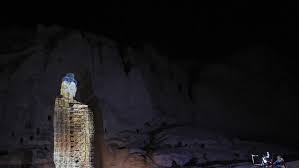
Twenty years after being blasted out of Afghanistan’s rugged central highlands, one of the country’s famed Buddha statues made a brief virtual return as a three-dimensional projection.
Daily Current Affairs Quiz 2021
In March 2001, the Taliban began blowing up two monumental Buddha statues in Afghanistan’s Bamiyan Valley.
Now, two decades later, on the anniversary of the annihilation, the Bamiyan Buddhas have been brought back to life in the form of 3D projections in an event called “A Night With Buddha”.
In their Roman draperies and with two different mudras, the Bamiyan Buddhas were great examples of a confluence of Gupta, Sassanian and Hellenistic artistic styles.
They are said to date back to the 5th century AD and were once the tallest standing Buddhas in the world.
Salsal and Shamama, as they were called by the locals, rose to heights of 55 and 38 metres respectively, and were said to be male and female. Salsal means “light shines through the universe”; Shamama is “Queen Mother”.
The statues were set in niches on either ends of a cliff side and hewn directly from the sandstone cliffs.
Following the fall of the Bamiyan Buddhas, UNESCO included the remains in its list of world heritage sites in 2003, with subsequent efforts made to restore and reconstruct the Buddhas in their niches with the pieces available.





